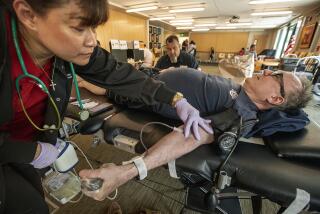Transfusion AIDS Risk Scaled Back : Red Cross Finds Incidence Decreases Annually by 30%
- Share via
The risk of becoming infected with the AIDS virus through a blood transfusion may be “fourfold fewer than reported previously,” according to a new study by American Red Cross researchers published in today’s New England Journal of Medicine.
The study also cites preliminary data that the AIDS risk to recipients of blood transfusions “has been decreasing by more than 30% a year” between 1985 and 1988.
But AIDS experts disagree about whether the new estimate--one infected unit per 153,000 units of blood transfused--is likely to be more accurate than a previous estimate--one in 40,000--which was published by U.S. Centers for Disease Control (CDC) researchers in the same journal last year.
No matter which estimate is believed, the overall risk of AIDS infection by transfusion remains quite small when compared to other commonly accepted risks. For example, the risk of being killed in an automobile accident in the United States is about one in 5,000 per year.
The new estimate is “good news,” Dr. Jay E. Menitove of the Blood Center of Southeastern Wisconsin in Milwaukee said in a telephone interview. The overall risk of transfusion infection is “very, very small. . . . We really are now dealing at the very marginal edge in terms of reducing risk further.”
The various estimates are “not that different,” said the CDC’s Dr. John W. Ward, who led the research team that prepared the earlier estimate. “All of them are estimates,” Ward said in a telephone interview from Atlanta. “None of them are direct measures (of the number of AIDS-infected units of blood that escape detection).”
After reading the study, Ward said there is a “possibility” that the AIDS risk from transfused blood is decreasing but added “we don’t want to decrease our vigilance.”
The American Red Cross study is one of three articles on transfusion AIDS published in the New England Journal, along with an editorial by Menitove that calls on blood banks and public health officials to work harder to prevent individuals likely to be infected with the human immunodeficiency virus (HIV), the cause of AIDS, from donating blood.
Among the strategies that are advocated are more explicit questioning of prospective donors about their risk of HIV infection and recruiting more female blood donors, who as a group are less likely than men to be infected with HIV.
The laboratory tests performed on all donated blood to detect the AIDS virus are accurate, but not foolproof. As a result, if HIV-infected individuals donate blood, some contaminated blood may escape detection.
Over the last two years, most estimates of the risk of becoming infected with HIV through a blood transfusion have been in the range of one in 40,000 to one in 60,000 per unit of blood transfused. Because the typical transfusion patient receives about five units of blood, the actual risk to the average patient would be higher.
The new estimate is based on data from 17 million American Red Cross blood donations between April, 1985, and December, 1987. It was prepared by a research team led by Paul D. Cumming.
Using data on the incidence of HIV-positive blood donations and on the accuracy record of HIV blood tests, the researchers estimated the chances that an infected unit would slip through undetected.
They estimated that between 67 and 227 HIV-positive blood units “entered the nation’s blood supply undetected in 1987” out of 20 million units of blood and its components transfused annually. Their best estimate was 131 units, which corresponds to a risk to a patient of one in 153,000 per unit transfused.
The American Red Cross study also cited a “preliminary analysis” of 1988 data. This showed that the “most likely number of HIV-positive units entering the blood supply” declined from 368 units in 1985 to 87 units in 1988.
By comparison, the CDC, using a slightly different method, estimated in a February, 1988, New England Journal article that “as many as 460 recipients of screened blood may become infected annually.” This corresponds to a risk to a patient of about one in 40,000 per unit transfused.
Ward pointed out that the American Red Cross does not collect blood in New York City, large parts of Texas and San Francisco, areas with relatively large numbers of HIV-infected people.
As of the end of July, there had been about 102,600 AIDS cases in the United States, including about 2,700 cases of transfusion-related AIDS, according to federal statistics. An estimated 12,000 transfusion recipients in the United States were infected with HIV before testing of the blood supply began in March, 1985.






